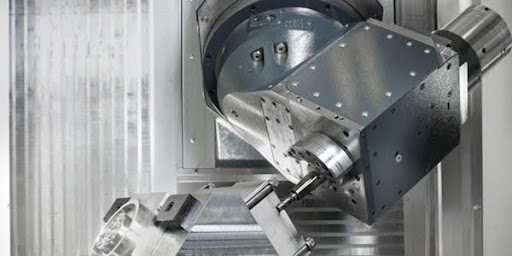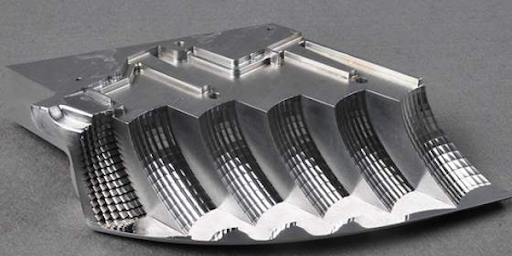To sign up for our daily email newsletter, CLICK HERE
Aerospace manufacturing is a highly precise and safety demanding industry and the introduction of any process technology must be rigorously evaluated. The application of CNC multi-axis machining technology is important to aerospace manufacturing because it can increase the precision, complexity and productivity of components. In this field, the manufacture of aerospace components often requires highly precise machining, and CNC multi-axis machining technology can achieve higher machining accuracy and greatly reduce the interference of human factors.

(1) 5-Axis CNC Milling Machines
5-axis CNC milling machine is a kind of machine tool that can simultaneously control the movement of tools and workpieces in five axes. Usually, it includes X, Y, Z three linear axes and A, C two rotary axes. This structure allows a 5-axis machine to rotate and move in complex ways to achieve multi-angle, multi-directional cutting operations. 5-axis CNC milling machines have a wide range of applications in aerospace manufacturing. They can machine aerospace components with complex curved surfaces and multi-angle features, such as turbine blades, combustion chamber parts, and fuselage components. These parts usually require high precision and surface quality, and the flexibility of five-axis machines allows them to meet these requirements.
(2) 6-Axis CNC Robots
6-axis CNC robots have six rotary axes and are often used to handle workpieces in three dimensions. They can perform complex manoeuvres such as bending, rotating and tilting. In aerospace manufacturing, 6-axis CNC robots are commonly used to automate assembly lines and welding jobs. They are able to accurately position and mount aerospace components while improving productivity and quality consistency. For example, in aircraft assembly, 6-axis robots can be used to install components such as wings, tails and aircraft casings.
(3) Multi-Axis CNC Lathes
Multi-axis CNC lathes have multiple rotary and linear axes and are typically used to machine rotationally symmetrical workpieces. They enable complex cutting operations such as threading and gear machining. In aerospace manufacturing, multi-axis CNC lathes are often used to machine engine components such as turbine shafts and turbine blades. These components have rotational symmetry, so multi-axis lathes are able to perform machining tasks efficiently. In addition, multi-axis lathes are also used for machining aircraft landing gear parts and connecting rods.
(4) Seven-Axis CNC Machines

Seven-axis CNC machine tools add two linear axes on the basis of five-axis CNC milling machines, providing a greater range of motion and flexibility. Seven-axis CNC machine tools are often used in aerospace manufacturing to process complex workpieces, such as compressor blades for aircraft engines. These blades have complex spatial curves, and 7-axis machines are able to achieve high precision machining in a more free-flowing manner.
Turbine Blade Manufacturing
An aerospace manufacturing company uses a 5-axis CNC milling machine to manufacture turbine blades, one of the key components in aircraft engines. A 5-axis CNC milling machine is a highly flexible machining machine with the ability to control the movement of tools and workpieces in five axes simultaneously. This machine allows complex cutting operations and is suitable for machining workpieces with complex curved surfaces and multi-angle features, such as turbine blades.
Key Steps in Turbine Blade Manufacturing
Mathematical Modeling
Mathematical modelling is a critical first step in turbine blade manufacturing. Engineers use computer-aided design (CAD) software as well as mathematical modelling techniques to create an accurate 3D model of the turbine blade. This model includes the complex geometry of the blade, airflow channels and surface details. Through mathematical modelling, each dimension and curvature of the blade can be precisely defined, providing an accurate reference for subsequent machining.
Tool Path Planning
Once the mathematical model of the blade is available, tool path planning becomes a crucial step. Dedicated tool path planning software is used to determine the trajectory of the tool to minimise machining time and ensure high accuracy. Path planning requires precise control of the tool’s movement to ensure that the cut is stable and accurate. This includes the optimisation of parameters such as the start and end points of the cut, direction of cut, depth of cut and cutting speed.
High-Speed Cutting Technology

High speed cutting technology is widely used in turbine blade manufacturing to improve productivity and ensure surface quality. High-speed cutting reduces machining time by utilising high-speed rotating tools and rapid cutting motion. It also helps to reduce the cutting temperature and reduce the heat affected area, thus improving the surface quality. High-speed cutting also reduces cutting forces, extends tool life, and reduces cutting vibrations, further improving machining accuracy.
Conclusion
CNC multi-axis machining technology is crucial for the advancement of aerospace manufacturing. Each type of multi-axis machine tool, from five-axis CNC milling machines to seven-axis CNC machines, plays a vital role in producing high-precision and complex aerospace components. Through precise mathematical modeling, meticulous tool path planning, and advanced cutting technologies, manufacturers can meet the demanding requirements of the aerospace industry and ensure the production of high-quality parts.